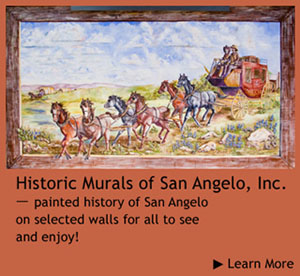Public Transportation in San Angelo, 1840 - 1940
The Stagecoach
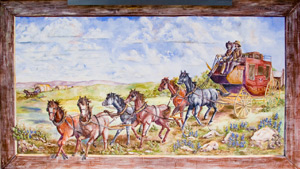
20' wide x 14’ high
This first mural in the Historic Murals of San Angelo transportation series is focused on the wagon trains and the overland stagecoaches that brought mail and settlers to the Concho Valley. Stagecoach travel was filled with excitement as stage owners regularly reported that their way stations were being attacked and that drivers, guards and passengers were being killed by Indian raiding parties.
A few hunters, trail scouts and explorers had ventured into West Texas in the early 1820s, and by the late 1840s, some had made their way and settled near the Concho River. There is a lone gravestone 12 miles north of San Angelo that marks the trail and a spot on top of the hill where a man named Dave Macey died in 1847. Pioneer families continued to arrive by wagon trains as pictured off in the distance in this mural. By the late 1850s, although Fort Concho and San Angelo had not yet been established, the Butterfield stage line established a stop at the Bismark Farm south of the town. The original farmhouse still stands as the oldest house recorded in Tom Green County.
Stagecoach operations in Texas were closely tied to government mail contracts. The stagecoach in this mural represents the Butterfield Overland Mail line that used Concord brand coaches in its mail and passenger stage service. The coaches were easily identified by their bright red color with yellow trim and the U.S. Mail Eagle emblem on the passenger door. Starting from St. Louis, Mo., and Memphis, Tenn., the local Butterfield line went west through Carlsbad, across the headwaters of the Middle Concho River, to a stop at Horsehead Crossing on the Pecos River, through El Paso and on to San Francisco, California.
Many of the six-horse stagecoach drivers dressed in long linen dusters for protection from dust, rain and wind; gauntlet-style gloves; wide-brimmed hats; and knee-high leather boots. Many also carried a whip. Henry Skillman is remembered as the driver of the first west-bound Butterfield Overland Mail stagecoach after the company won a government contract to haul the mail and passengers all the way to California. On that first trip, Skillman took over the reins of the stage at the Horsehead Crossing Station on the Sunday morning prior and drove for 96 hours without rest, arriving in El Paso before dawn on Thursday, Sept. 30, 1858.
Skillman probably knew, or at least knew of, other famous stagecoach drivers, like Charley Parkhurst. Also known as “One-Eyed Charley” or “Six-Horse Charley,” Parkhurst worked for the California Stage Company and had a reputation as one of the finest stagecoach drivers, or “whips,” on the West Coast. Also known as a driver who could drink, swear and chew with the best of men, it wasn’t until Parkhurst died in 1879 that folks found out that “he” was actually a woman, born Charlotte Darkey Parkhurst in 1812. She is buried in The Old Pioneer Odd Fellows Cemetery in Watsonville, California.
Mural artist Crystal Goodman also added “critters” found in West Texas–horned toads, road runners, armadillos, rattlesnakes, prairie dogs, scorpions and tarantulas. The landscape is covered with prickly pear cactus and colorful bluebonnet flowers that are prominent throughout most of Texas in mid-April.
There is a Texas legend about a severe summer drought and how a Comanche Indian chief asked that someone in the tribe give up a most valued possession as an offering to the Great Spirit so they might have rain. In the night, the chief's small daughter went to the top of a hill and left her corncob doll with its bonnet of bright blue feathers. The next morning, rain fell and a beautiful field of blue flowers covered the hillside–the Texas bluebonnet.
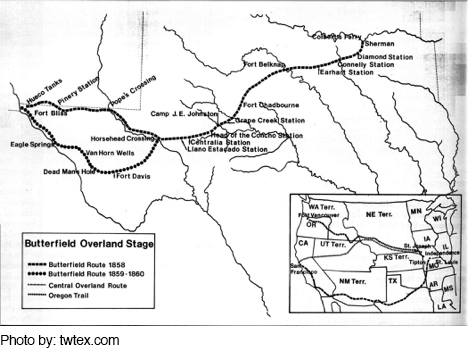
The Santa Fe Depot
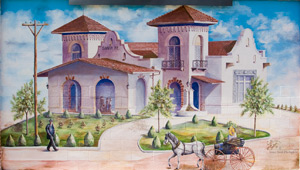
20' wide x 14’ high
The Santa Fe Depot mural is part 2 of The Historic Murals of San Angelo transportation series. It is a historically accurate painting of the Santa Fe train depot that the railroad constructed in San Angelo in 1908. This mural is located at South Chadbourne Street and Avenue C, across from the old Santa Fe/Orient Depot. Whereas the many stagecoach lines (e.g., Butterfield and Wells Fargo) were named after the individual owners and investors, trains were identified by their individual line routes.
The Gulf, Colorado and Santa Fe Railway Company (GC&SF) was chartered on May 28, 1873, to build a railroad from Galveston to the interior of Texas. The town of Ballinger was established when the GC&SF built westward out of Brownwood in 1886. In 1888, the company completed a 35-mile extension from Ballinger to San Angelo. This action essentially ended the overland stage business as the faster and more comfortable railroads easily won the government mail and passenger contracts. At the same time, it seemed the whole of Texas was also building passenger, mail, freight and livestock trains from town to town as fast as possible.
San Angelo became a shipping center with the coming of the Santa Fe railroad. Thousands of people came to San Angelo to greet the first train and Steam Engine No. 18 when it arrived from Ballinger on Sept. 30, 1888. The crowd celebrated for two days with the roar of artillery, a parade and a dance. There is more about steam-powered trains in The 503 Iron Horse mural.
On Dec. 12, 1895, the Santa Fe was reorganized as the Atchison, Topeka and Santa Fe Railway Company and subsequently acquired a number of railroads that were leased to the GC&SF for operation in Texas. This new company name may be familiar to some viewers who remember the No. 1 hit song by the same name sung by Judy Garland in the 1946 film, “The Harvey Girls.”
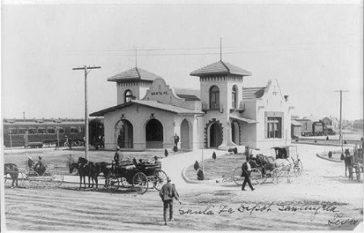
When its original station burned to the ground in 1908, the Santa Fe railroad promptly constructed the new depot featured in this mural. It was an impressive building with its distinct New Mexico Santa Fe-style architecture, including the white stucco exterior and red tile roof. The artist, Crystal Goodman, discovered specific details of the craftsmanship in the building by enlarging an original 8-by-10-inch, black-and-white photo taken by San Angelo’s most remembered photographer, M.C. Ragsdale.
Goodman later found a 1908 color postcard of the depot that she used to make sure the design and color of the building trim work are historically accurate. At about the same time as that photo was taken in 1908, the Kansas City, Mexico and Orient Railway of Texas (KCM&O) brought its first passenger trains into town. By the 1920s, San Angelo had grown from a frontier fort to a small rail station to the gateway for shipments of over 5,000 railcars of livestock each year. All the wool from southwest Texas also passed through the city. In 1928, Santa Fe bought out the KCM&O and operated it as a subsidiary of the Santa Fe through the 1940s. In 1941, the Santa Fe extended its line two miles to the new Goodfellow Air Force Base being constructed southeast of San Angelo.
Santa Fe moved its operations and administration to its newly acquired and much larger KCM&O building at 703 South Chadbourne Street and closed this old Spanish-style depot on August 1, 1929. This once-prominent transportation building would later be used as a meeting place for several local groups until Santa Fe decided to reduce the company tax and personal liability costs and leveled it on August 24, 1947. Santa Fe closed all of its San Angelo passenger and freight operations in 1985. A nonprofit organization, The Historic Orient/Santa Fe Depot, Inc., currently operates a railway museum in the KCM&O Chadbourne Street building.
The 503 Iron Horse
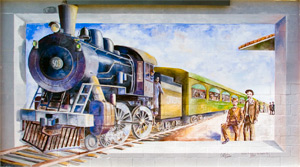
20' wide x 14’ high
The 503 Iron Horse mural is Part 3 of the Historic Murals of San Angelo transportation series. Painted in 2002 by Crystal Goodman, this mural continues the history of the railroad and its influence on economic and industrial growth in San Angelo and West Texas. Whereas the many stagecoach lines (e.g., Butterfield and Wells Fargo) were named after the individual owners and investors, trains were identified by individual engine names and numbers, as well as their assigned geographic routes.
Many of the earliest steam locomotives for American railroads, like the Stourbridge Lion, were imported from Great Britain before the domestic manufacturing industry really got started. In 1830, the Baltimore and Ohio Railroad’s Tom Thumb was the first American-built locomotive to run in the U.S. The Buffalo Bayou, Brazos and Colorado Railway Company (BBB&C) was chartered for operations in Texas on Feb. 11, 1850, and its first steam-powered locomotive arrived in late 1852. The BBB&C was not only the first railroad to operate in Texas, it was the second railroad west of the Mississippi River and the oldest component of the present Southern Pacific.
After being designated as the county seat in 1883, San Angelo grew quickly and became a transportation hub for the Santa Fe and the Kansas City, Mexico and Orient (KCM&O) railroad companies in 1888 and 1908, respectively. Having both railroads in San Angelo connected the city to Ballinger, Miles, Rowena, Brownwood, Houston, Dallas, Fort Worth and Altus, Oklahoma.
The Iron Horse No. 503 engine, shown in the mural with its 4-4-0 drivetrain and two-man crew, was one of the first trains to stop at the San Angelo depot, according to historian and photographer, Allen Johnston. It is pictured along with its tender, painted with the Orient line markings. During the West Texas oil boom of the mid-1920s, a steam engine like this one rolled through San Angelo every hour pulling cars full of passengers, equipment, business freight, livestock and oil east and west across Texas. The distinctive sounds of steam engines hauling heavy loads and their unmistakable whistles and clanging bells as they approached towns and crossings marked this significant era in the history of our state.
The artist painted T.A. Jones and A.J. Jones (not related) as the engineer and fireman on the mural train. Both these men had operated similar engines in the mid-1860s and 1870s. Most of the passengers on the train are people the artist thought of as she painted their faces. Rick Smith, a San Angelo Standard-Times columnist who wrote about the mural in one of his newspaper columns, is painted in the front row as the passenger making notes. The two gentlemen waiting near the travel trunks were copied from a vintage photo belonging to Helen Arthur Fenton, a native San Angeloan whose father was a train conductor.
This mural captures just some of the excitement that passengers might have experienced when boarding the "The Angelo" train No. 77 on the Gulf, Colorado & Santa Fe line in the late evening, knowing they would arrive in Fort Worth in time for breakfast. Imagine them traveling along faster than many ever thought possible, looking out of the windows at scenery not yet seen in their lifetime–all the while enjoying dining and lounge car services. It was these experiences that newspaper men like Rick Smith documented as they visited with travelers at the depots and on the trains.
Texas railroads and Iron Horse steam locomotives like No. 503 were unquestionably the biggest economic force in Texas prior to the discovery of oil and the awakening of military and civil aviation.
The Cromwell Airlines
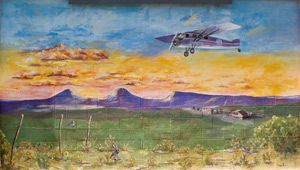
20' wide x 14’ high
The Cromwell Airlines mural represents the beginning of scheduled airline passenger service in San Angelo. This is the fourth and final painting in the Historic Murals of San Angelo transportation series. The entire series is located across from the old Santa Fe/Orient Depot at South Chadbourne Street and Avenue C.
Carl G. Cromwell made his personal wealth working in the Big Lake Oil Field, where he is credited with drilling the famed Santa Rita No. 1. When that well blew in on May 28, 1923, it brought great fortune to the University of Texas at Austin, huge profits to Texon Oil and Land Company, and enough money for Cromwell to purchase his own leases and finance other business and aviation interests.
In 1928, while watching a group of Fort Worth Aerocade pilots flying a mix of post-World War I aircraft in thrilling speed (air racing) and acrobatic (barnstorming) demonstrations, Cromwell became an ardent aviation advocate and began to think of ways to use an airplane to improve his oilfield operations. The same year, he purchased a very fast Lockheed Vega 5-B and named it the Miss Carlene in honor of his daughter.
The Vega 5-B significantly improved company communications and the efficiency of spare parts delivery, and Cromwell promoted these successes in his pitch for San Angelo to build a municipal airport. The San Angelo Board of City Development finally constructed an airport with a hangar and administration building in 1929, and Cromwell began using those buildings as the headquarters for his new company, Cromwell Air Lines. The airline purchased two Stinson SM-6B Detroiter aircraft, and on November 1, 1929, began regularly scheduled flights from San Angelo to Dallas, Dallas to San Angelo, and Dallas to San Angelo via Fort Worth. A one-way ticket from San Angelo to Dallas cost $17.
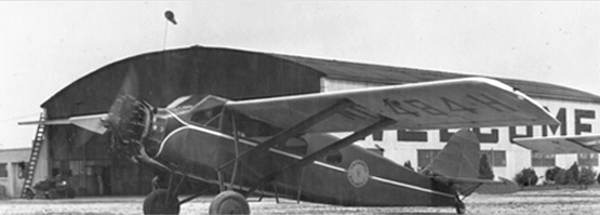
Stinson SM-6B parked at San Angelo Municipal Airport, circa 1930.
Photo from Erik Carlson Presentation, 2005, Darnell Collection.
Just as it might have appeared in 1930, this mural features one of the Stinson SM-6B airplanes flying over the small San Angelo municipal airport with the familiar Twin Buttes landscape in the distance. One might surmise that the second Cromwell Airlines Stinson is also in the air on its way to San Angelo from Dallas while Cromwell’s personal Vega 5-B sits parked to the right of the administration building. The double-door hangar and crushed stone surfaces complete the early airport scene.
As is her custom, artist Crystal Goodman added familiar Texas critters to this painting. The roadrunner and jackrabbit, ever on the lookout for predators, share the sunset and landscape with a lone mockingbird perched on the barbed-wire fence. There is also a field mouse watching, as well as several Indian arrowheads scattered around on the ground.
Cromwell Airlines was short-lived as the small population base couldn’t sustain the number of passengers needed to make it profitable. Also, overall poor economic business conditions in West Texas and the Great Depression across America caused Cromwell to close the airline by July of 1930 and dedicate himself to running his Apollo Oil Company. While on a business trip near Sheffield, Pennsylvania, Cromwell was killed in a tragic automobile accident on September 27, 1931. His body was returned to San Angelo, where memorial services were held at the Robert Massie Chapel, with interment in Fairmount Cemetery.
After his death, the remaining airline assets were sold, but Cromwell's daughter, Carlene Peavey, stayed in contact with former company pilot, James Walker. In a 1995 note, Walker wrote to Peavey stating how much he still thought of her father and how thankful he was for the opportunities Cromwell had given him many years before with Cromwell Airlines. Walker's note is a true tribute to the Cromwell legacy in commercial aviation as we know it today.
For more detailed information, please consult the following reference:
Carlson, Erik, "Carl G. Cromwell and Cromwell Airlines: The Dawn of Commercial Aviation in West Texas, 1928-1931." West Texas Historical Association Yearbook Vol. LXXIX (2003): 89-105.
|








